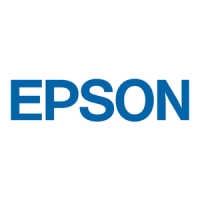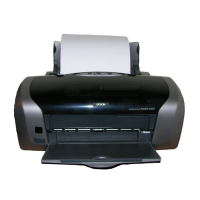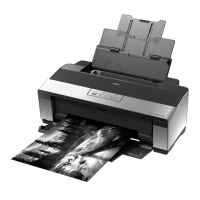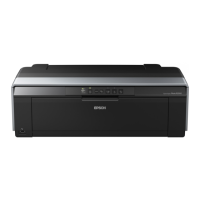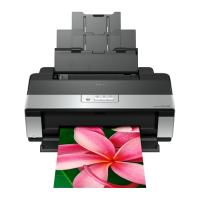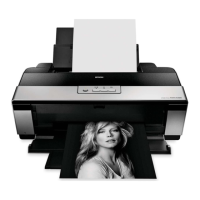How to check if paper exists in Epson Stylus Photo R290?
- NNorma GilesAug 19, 2025
To check if paper exists in the Epson Printer, check the PE Sensor. A reading of 0.4V or less indicates that paper is present.
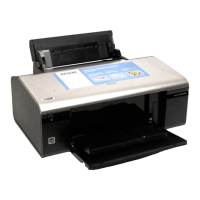
How to check if paper exists in Epson Stylus Photo R290?
To check if paper exists in the Epson Printer, check the PE Sensor. A reading of 0.4V or less indicates that paper is present.
How to check if there is no paper in Epson Stylus Photo R290 Printer?
To check if there is no paper in the Epson Printer, check the PE Sensor. A reading of 2.4V or more indicates that there is no paper.
What to do if Epson Stylus Photo R290 Accessories isn't recognizing cartridges after CI system install?
If your Epson Printer Accessories isn't recognizing some cartridges after installing the CI system, remove the cartridges, turn off the printer, and then reinstall the cartridges. After this, you should be able to continue printing.
How to check if Epson Stylus Photo R290 Printer cover is opened?
To determine if the Epson Printer cover is opened, check the Cover OPEN Sensor. A reading of 2.4V or more indicates that the printer cover is open.
How to check if Epson Stylus Photo R290 cover is closed?
To determine if the Epson Printer cover is closed, check the Cover OPEN Sensor. A reading of 0.4V or less indicates the printer cover is closed.
How to check if Epson Stylus Photo R290 Printer is in CDR mode?
To determine if the Epson Printer is in CDR mode (stacker at the upper position), check the CDR Guide Sensor. An open reading of 2.4V or more indicates CDR mode.
How to check if Epson Printer is in ASF mode?
To determine if the Epson Printer is in ASF mode (stacker at the lower position), check the CDR Guide Sensor. A closed reading of 0.4V or less indicates ASF mode.
How to check if CD-R Tray is inserted in Epson Stylus Photo R290?
To check if the CD-R Tray is inserted in your Epson Printer, examine the CD-R Tray Sensor. An open reading of 2.4V or more indicates that the CD-R Tray is inserted.
How to check if there is no CD-R Tray in Epson Printer?
To check if there is no CD-R Tray in your Epson Printer, examine the CD-R Tray Sensor. A closed reading of 0.4V or less indicates that there is no CD-R Tray.
How to check if Epson Stylus Photo R290 Printer is within PG position?
To check if the Epson Printer is within PG position, check the APG Sensor. A reading of 2.4V or more indicates that it is within PG position.
| Color | Yes |
|---|---|
| Maximum resolution | 5760 x 1440 DPI |
| Print speed (black, normal quality, A4/US Letter) | 37 ppm |
| Print speed (color, normal quality, A4/US Letter) | 38 ppm |
| Total input capacity | 120 sheets |
| Envelopes sizes | DL |
| Standard media sizes | A4, Letter, Legal, 8x10\ |
| Paper tray media types | Envelopes, Photo paper, Plain paper |
| Non-ISO print media sizes | Legal |
| ISO A-series sizes (A0...A9) | A4, A5, A6 |
| ISO C-series sizes (C0...C9) | C6 |
| Maximum ISO A-series paper size | A4 |
| Compatible operating systems | Win 98SE/Me/2000/XP/XP x64/Vista, Mac OS 10.2 / OS 10.5 Bundle available on CD |
| USB 2.0 ports quantity | 1 |
| Dimensions (WxDxH) | 450 x 282 x 187 mm |
| Power requirements | AC 220 - 240V, 50 - 60 Hz |
| Bundled software | Epson File Manager Epson Scan Assist Epson Attach to Email Epson Easy Photo Print Epson Print CD Epson Web-To-Page Reference Guide |
| Printing noise level | 36 dB |
| Power consumption (standby) | 0.3 W |
| Power consumption (printing) | 12 W |
| Market positioning | Home & office |
| Depth | 282 mm |
|---|---|
| Width | 450 mm |
| Height | 187 mm |
Overview of key capabilities like high resolution, speed, and special printing features.
Details on print method, resolution, ink cartridge compatibility, and paper handling.
Information on USB connectivity standards and recommended cable length.
Electrical specifications, power consumption, and environmental operating conditions.
Explanation of printer control buttons and status indicator LEDs.
Introduction to printer mechanisms and main control boards.
Explains systems for reducing banding and improving paper feed accuracy.
Step-by-step process the printer follows when powered on.
Describes various methods for initializing the printer's settings and mechanism.
Guide to troubleshooting based on error messages, LED status, and symptoms.
How the printer signals errors via LEDs or driver messages.
Detailed procedures for resolving issues indicated by specific error messages.
Steps to diagnose and fix problems identified by observable symptoms.
Introduction to disassembly procedures for printer components.
Safety warnings and precautions for disassembly and reassembly.
Lists specific tools required for disassembly and assembly.
Identifies different screw types used in the printer assembly.
Instructions on creating a custom tool for removing the CSIC board.
Checklist to ensure all service tasks are completed before returning the printer.
Steps to take before beginning disassembly, like backing up data.
Procedure for unlocking the print head carriage for component removal.
Highlights differences in disassembly procedures for specific printer models.
Visual guide outlining the step-by-step process for disassembling the printer.
Procedures for removing external printer parts.
Instructions for removing the printer's outer cover.
Procedure for detaching and removing the paper support mechanism.
Steps to remove the paper stacker assembly and its cover.
Guide to removing the top section of the printer's housing.
Procedures for accessing and removing internal electronic boards.
Detailed steps for removing and replacing the printer's main logic board.
Procedure for removing the printer's control panel and cover sensor.
Instructions for removing the printer's power supply unit.
Step-by-step guide to detach the main printer mechanism assembly.
Step-by-step guide to detach the main printer mechanism assembly.
Detailed procedure for removing the print head assembly for replacement.
How to remove and reinstall the carriage scale for maintenance.
Steps to remove and reinstall the automatic platen gap adjustment unit.
Procedure for removing the waste ink tray to prevent spills.
Instructions for replacing the waste ink pads.
Steps for removing paper guides and the CD/DVD tray sensor.
Guide to removing the ink delivery system components.
Procedure for removing the ejector frame assembly.
Steps for removing the paper feed encoder and scale.
Instructions for removing the paper feed motor.
Procedure for removing the carriage motor.
Detailed steps for removing the carriage unit.
Instructions for removing the automatic sheet feeder unit.
Steps to remove the upper paper guide assembly.
Procedure for removing the automatic platen gap sensor assembly.
Steps to remove the front paper guide assembly.
Procedure for removing the CD/DVD tray sensor.
Specific disassembly and reassembly procedures for certain Epson models.
Disassembly and reassembly of the control panel for specific models.
Introduction to necessary adjustments after component replacement.
Lists all adjustable items and their purpose.
Table indicating which adjustments are needed based on replaced parts.
How to operate the adjustment software and interpret printed patterns.
Procedure to correct the top margin of printouts.
Steps to adjust print head alignment for optimal print quality.
Method to correct print start timing for better bidirectional printing.
Adjustments for sensor position and first dot printing location.
Procedure to correct paper feed accuracy for high print quality.
How to adjust the platen gap and parallelism for reliable print quality.
Guide to adjusting systems that reduce banding and improve paper feed.
Introduction to BRS/PFP adjustments, required tools, and scanners.
Step-by-step instructions for performing BRS and PFP adjustments.
Information on maintaining the printer for optimal performance.
Procedures for cleaning printer exterior parts, interior, and rollers.
Actions for print quality issues and maintenance request errors.
Routine cleaning to resolve print quality issues like missing dots or banding.
Actions for "Maintenance request error" involving waste ink pads and counters.
Specifies types and points for lubricating printer components.
Information on where to find exploded diagrams and parts lists.
